
It’s the comeback story of the year, maybe of our media lifetimes.
While we’ve been busy uploading millions of songs into hard drives these past many years, and moving our CD collections to the storage room, vinyl records have been on a fantastic journey – from dead as a doornail to alive and well. And it’s all quietly happened over the past 20 years when new media and gadgetry have remade our world.
Vinyl record albums (and 45 rpm singles) boomed in the 1950s and 1960s, then other formats – mostly more portable and playable in cars – gave vinyl a run for its money. As 8-tracks, cassettes, CDs, and of course, mp3 files each became the modern ways to listen to music, vinyl began its fade-out in the ’90s.
There were attempts – mostly lame ones – to install record players in cars. Plymouth excited music lovers for a minute with their “Highway Hi-Fi” turntable but drivers soon found them unreliable and more than a little distracting. 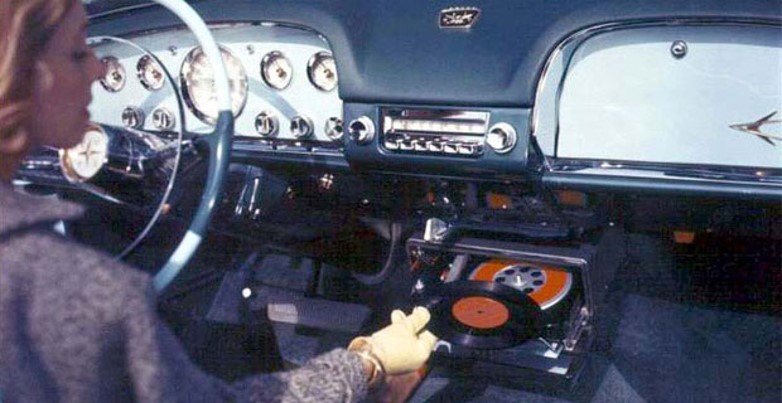
How bad did it get for vinyl records? In the early 1990s, sales fell like an anvil – and had no pulse for more than a decade. To say vinyl records were nearly extinct is an understatement.
And then in the early 2000s, the turnaround began. The chart below covering a 25-year period from 1978 until 2002 illustrates one of the most remarkable comeback stories in consumer history. While vinyl is nowhere near back to the levels it enjoyed in the late ’70s, it continues to show remarkable growth, re-reaching a billion dollars in sales two years ago.
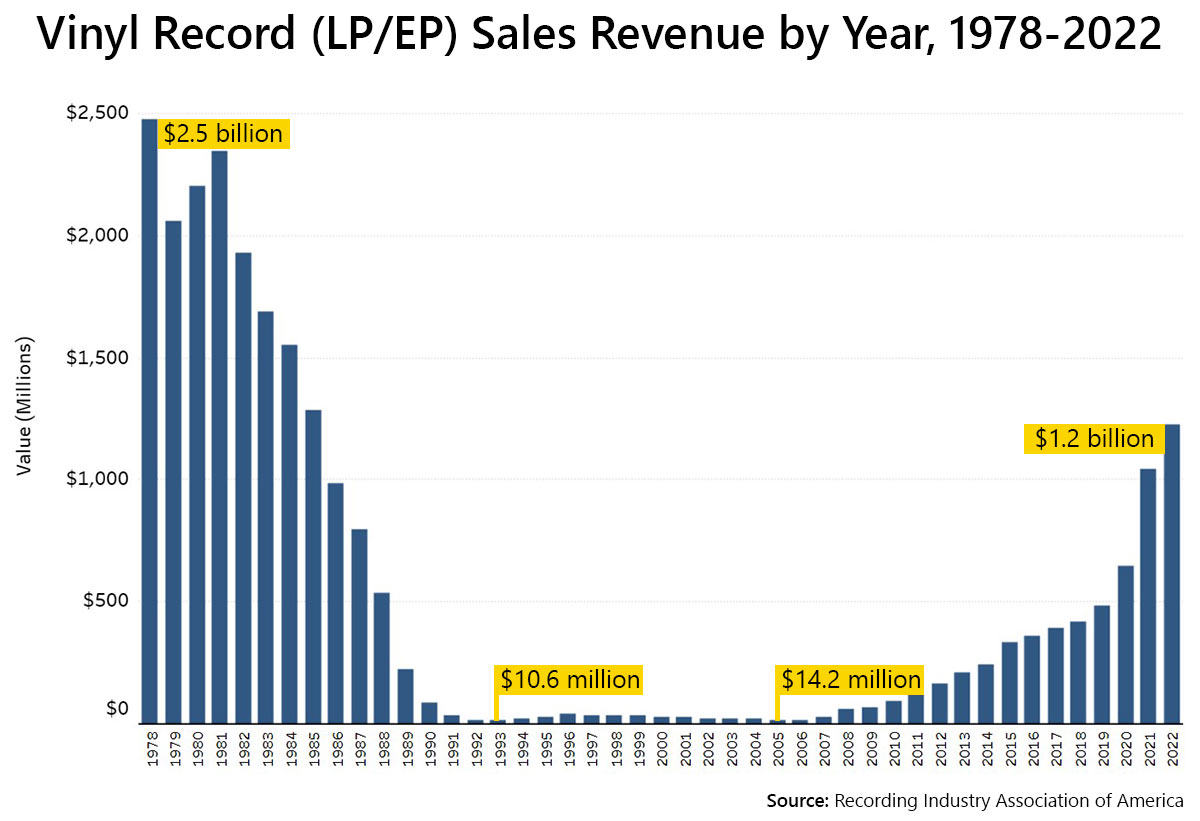
It’s mind-boggling, and almost unbelievable given our rapid techie trajectory these past two decades.
According to a thorough and fascinating analysis by Camoin Associates, an economic and lead-gen consulting firm, vinyl passed CDs in sales two years back, continuing to blow away all those doomsday predictions from the turn of the century.
How impressive is vinyl’s rebound? In the UK, it is now once again part of the ways in which they measure inflation, right there with the price of petrol, milk, and 742 other market basket items. This marks vinyl’s return to the list for the first time since 1992, according to The Guardian.
If you’re paying attention, you see turntables and stacks of vinyl records showing up in hotel lobbies and lounges, a throwback to bygone days. Unlike the way we listen to digital music – often with earbuds or headphones – vinyl records are most often enjoyed communally over speakers.
That’s the way songs are recorded and albums are mastered – on studio monitors that flow with the ambiance of a room or space. Open-air listening is less confining, allowing the listener to be present rather than isolated.
We noted the shift here in Detroit when Jack White (formerly of the White Stripes) opened a vinyl pressing plant at his Third Man Records facility in midtown Detroit over the Thanksgiving holidays in 2015. I was there that weekend, along with my family, welcoming what has become a a cultural icon in the Motor City. I also wrote a post here not long after, “Radio’s Vinyl Fling.”
Here’s the interesting part – turntable sales have risen during this period, but not commensurate with the explosive growth of vinyl. Our Techsurveys show the same trend – turntables have steadily grown, but nowhere near the meteoric rate we see with vinyl.
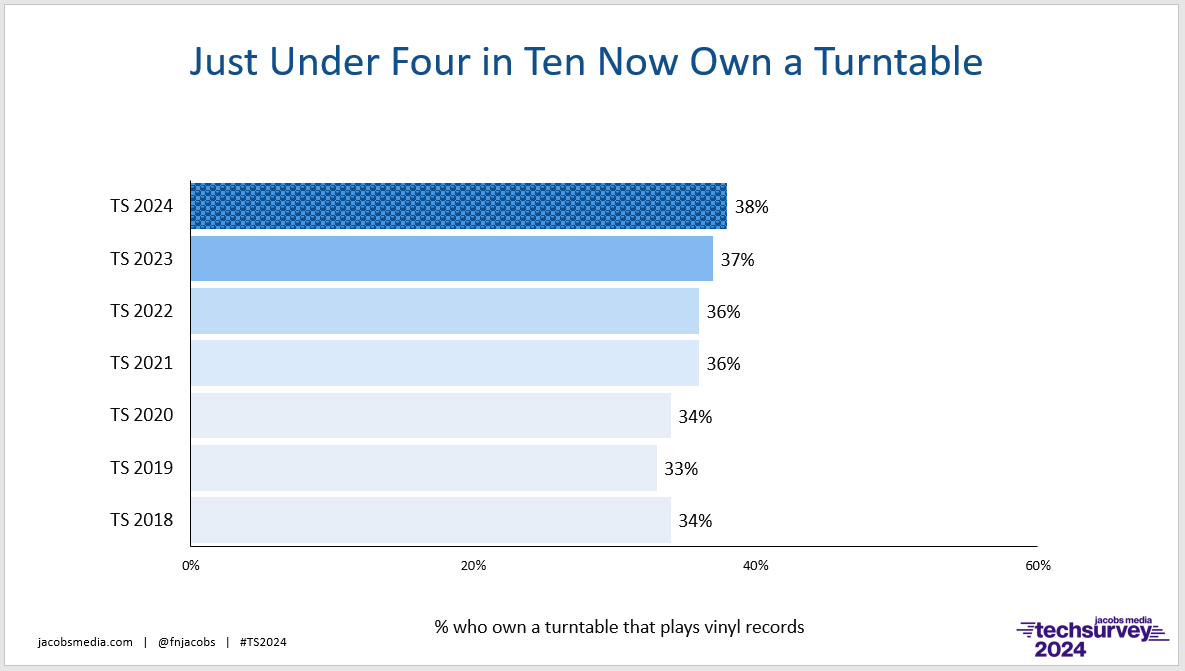
A possible explanation: Music Business Worldwide reports on a study by Luminate that “50% of consumers who have bought vinyl in the past 12 months own a record player…”
Of course, that means 50% don’t own a turntable. That stat underscores the trend that vinyl is both nostalgic and a valued collectible.
And that takes us back to the underlying reasons for vinyl’s rebound from its near-death experience, and whether we can take anything away from it.
Camoin Associates’ Jilayne Jordan lists six key factors that appear to have contributed to vinyl’s resurrection, some of which might have implications to radio:
1. Record Store Day – The before-and-after sales figure from 2008 when this event was launched tell a story. We’ve worked with College Radio Day and its “Vinylthon” event that conveniently falls at the same time. All the talk over the radio airwaves has to be a contributing factor in the vinyl story.
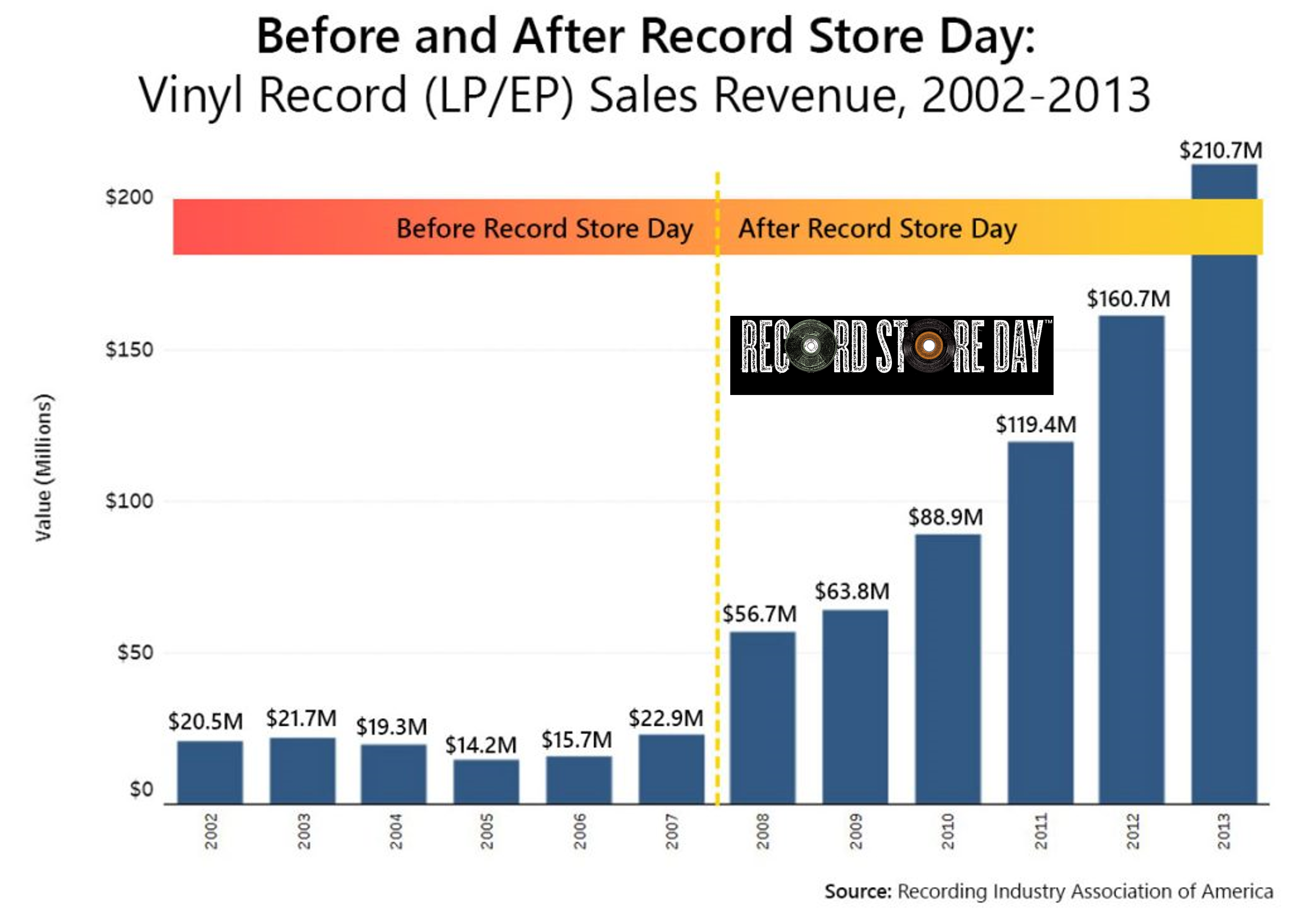
2. COVID – Jordan points to share vinyl sales increases once the pandemic got going in early 2020. She reasons consumers were seeking new hobbies and time-killers while spending more time at home. I would add to that the need for “comfort” activities. And for many, listening to your favorite records spinning on the turntable while you’re parked on the couch produces a warm and fuzzy feeling for many, leading us to…
3. Nostalgia – No doubt about it, the superpower of looking back to one’s “good old days” factors into vinyl’s growth. And I think you have to give the nod to Classic Rock, an album-oriented radio format (one of the few) that has drawn attention to vinyl over the years. Could Classic Rock radio stations better leverage this modern trend in listening and collecting?
4. Digital burnout – Jordan points to high-tech devices that consumers are no longer as enamored with – smartphones, earbuds, streaming – all artifacts of the times in which we live. How else can you explain the flip-phone phenomenon? Again, nostalgia is at work here.
the flip-phone phenomenon? Again, nostalgia is at work here.
5. Collectability – This is an important angle in vinyl’s unlikely rise, and it partially explains Luminate’s data point that half of U.S. buyers don’t even own a turntable. Those vinyl records – especially with shrink wrap still on – might make a great investment. Hopefully, you didn’t purge your collection at a garage sale.
6. Aesthetics – I felt this when the CD was launched in the early 1980s with those nice, neat, and easily stored jewel boxes. But in the process, we lost album art, liner notes, and all the other accoutrements of the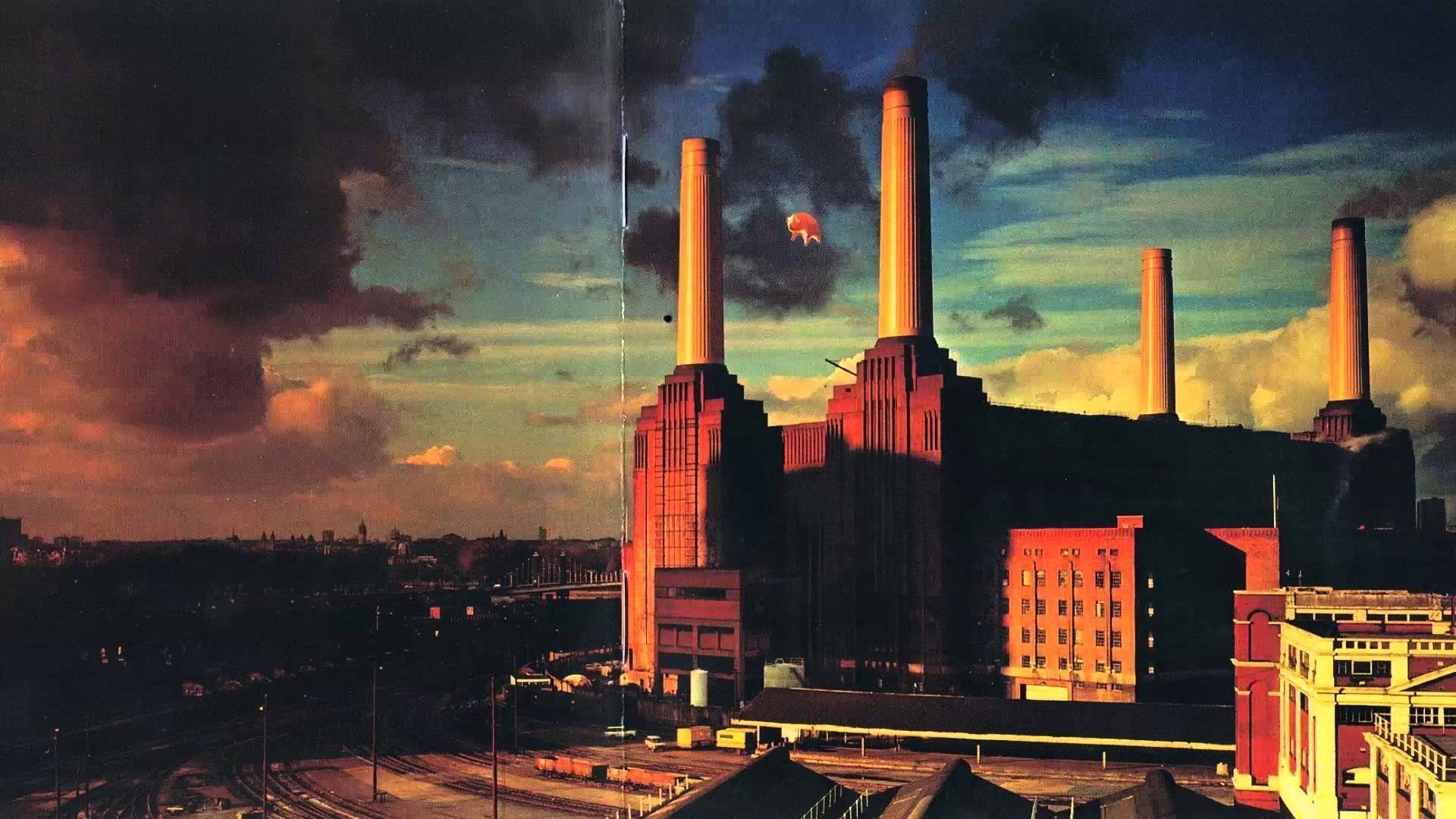 classic record jacket.
classic record jacket.
Back in the day, I was a fan of Roger Dean who created the album art for bands like Yes, as well as the Hipgnosis team that crafted (among others) all the ethereal Pink Floyd artwork for their albums.
When vinyl was on the outs, much of the culture surrounding rock music visuals was sadly lost.
But there may be another key factor at work that Jordana merely glosses over….
7. Taylor Swift – That’s right. Her 1989 release broke all-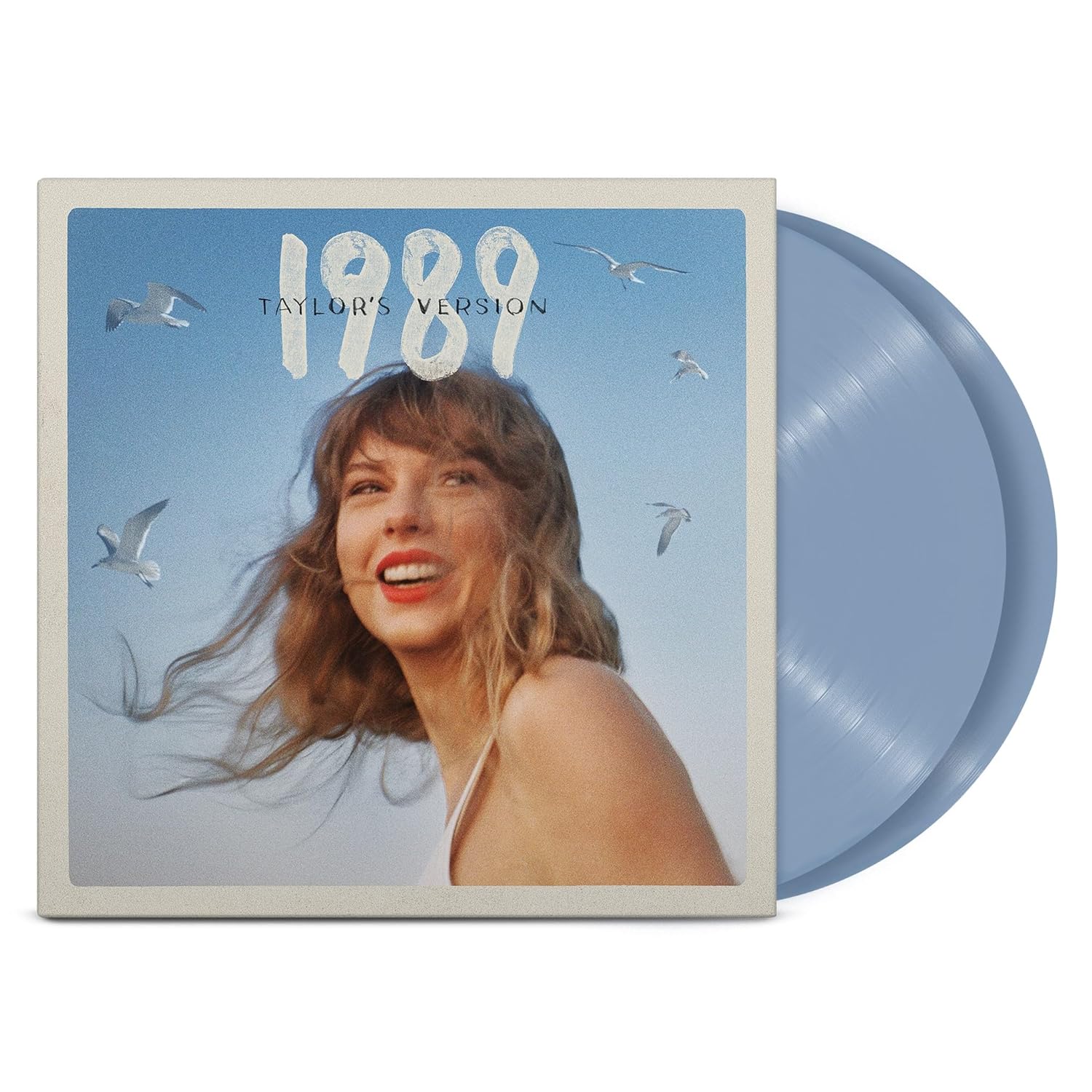 time weekly vinyl sales records last year. In its first six days, Luminate data shows the album sold a whopping 580,000 copies.
time weekly vinyl sales records last year. In its first six days, Luminate data shows the album sold a whopping 580,000 copies.
For radio, is there an opportunity here? Clearly, with giveaways. Back in the day, we regularly gave away concert tickets and albums (“win it before-you-can buy-it). Today, vinyl versions of big albums have more cachet than ever.
“All Vinyl Weekends” could move the needle, grab attention, and also give a station more cred. And then there’s the idea of flipping the whole station back to the turntable and records architecture. (What’s next? Cart machines?) I know…this would be a major investment and would perhaps represent more work and expense than the payoff.
But in a “Back To The Future” way, it could provide much-needed attention to a station that commits, as well as reorienting the attention spans of air talent – hopefully in a good way.
And finally, I couldn’t help but wonder as I was writing this post whether some of the same factors that have vaulted vinyl from the ashes could work for radio.
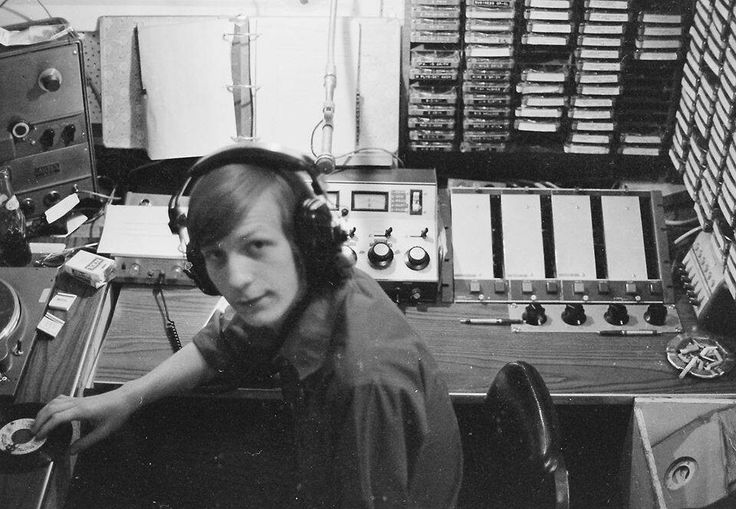
Nostalgia and the back-to-the-basics mindset in a world of algorithms, subscription fees, and streaming could provide the warmth and comfort we associate with vinyl.
Of course, a key difference is that playing Abbey Road on a turntable in 2023 sounds as good as it did in 1969 when the album was released.
Does radio today sound as good to consumers today as they remember it from 2000, 1990, or 1980?
I’ll leave that one to you.
P.S. That’s Jim Kerr pictured above, this week celebrating an amazing 50 years doing mornings in New York City. Born and raised in Detroit, Jim has set an incredible example for all of us in radio over the years. We wish him all the best and thank him for bringing class, quality, and commitment to FM radio. – FJ
- Who’s Got It Better? Talent In Commercial Radio vs. Talent in Christian Music Radio - June 4, 2025
- It’s The Christian (Radio) Thing To Do - June 3, 2025
- Is It Time For Radio to WAKE UP?! - June 1, 2025



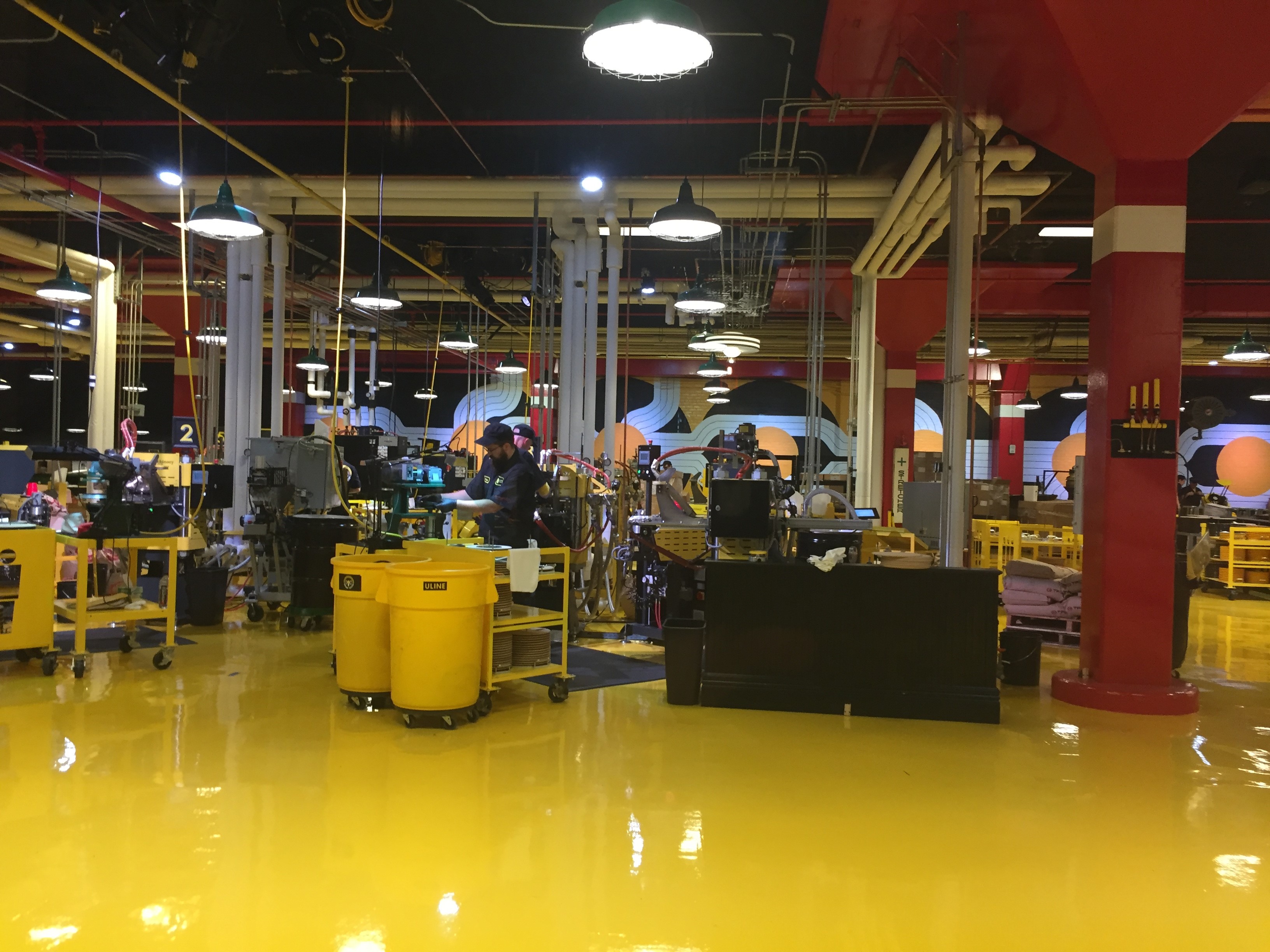

I’ve been waiting since we moved to our new studios in November to get my turntable hooked into the board.
It finally happened last Friday!
Time to find that sponsor for the Mid-Morning Vinyl Vamp!
If you need remedial lesson on how to slip cue a record, Bob, I’m your guy!
As some (alleged) German soldier once said, “Verry interesting.”
Btw, I couldn’t help but notice that the #1 reason *I* see/hear most often cited for vinyl’s remarkable comeback – “superior sound quality” – is not mentioned above. I don’t believe that to be true, but then again, I wear hearing aids. Your mileage may vary.
Indeed. I remember getting into an “argument” with an audiophile when CDs first hit the market. He tried to convince me albums “breathed” while CDs were compressed. I couldn’t tell the difference and I don’t think most listeners can either – especially with the audio processing cranked up to capture meteers.
Great read Fred- as a vinyl fan and collector since the mid-70’s it’s great to see this trend continue. It makes sense that those who grew-up with vinyl albums never lost the love of the experience of liner notes, artwork, special editions, etc., but the ongoing “discovery” by younger generations is cool. A friend of mine from Minneapolis recently sent me the entire Classic Rock library on vinyl. “Beatles A-Z” is nothing new, but a few years back we did it with every song played from vinyl and gave away vinyl copies of the catalog. On WRIF, our PM drive talent, Meltdown has “The Vinyl Frontier” feature. This past weekend here in Royal Oak, MI I saw a vendor at an art fair selling custom made crates to store albums in. That should tell you something.
Scott, it’s amazing how some habits never get old. And I think a station ike CSX or RIF telegraphs “we get it” when you do vinyl promotions. As for custom crates, whatever happened to milk crates?
Milk crates! Ha! Still have ’em!
Two points: I vividly remember a bit of a cringe whenever I had to play Bob Seger’s “Night Moves” because of the relatively long totally silent passage in the song generally always came with pops and ticks that the station compressor always brought right up to the forefront in the audio. I always would check the library to see if we had a fresh copy in the library, hated having to play that song off the Cart machine because the hiss was more obnoxious than the pop’s and tick’s. The second charming part of vinyl was getting stuck in the mens room while you had the LP version of Light My Fire playing to buy you the needed time, and it started skipping before you were able to leave the room… yes, many nostalgic vinyl memories 😉
Ahhh, the dark side of vinyl. I remember trying to keep clean copies of big albums in the studio. Amazingly, you’d put a brand new album, fresh out of the shrink rap, in the control room in the morning. By 5pm, it was scratched.
But I was thinking, what would a modern listener even think when a record started skipping. Not that it would be charming, but it would be kinda cool (the first time it happens!).
Just as bad was the piano intro to “Locomotive Breath” by Jethro Tull. Another one that instantly comes to mind: the end of “Over The Hills & Far Away” by Led Zeppelin. The pops, clicks and/or hiss essentially drowned out Jimmy Page’s guitar.
I’ve long believed the biggest single marketing mistake ever made in the music industry was a “Compact Disk” rather than a 12″ digital album. The LP jacket was a huge part of the album experience.
It was also “prep material” for the airstaff – lyrics, liner notes, credits, photoss – it was all there often in a beautiful package. Thanks, Bob.
What a great, fun article, and great comments to boot! I’m one of those that did argue for the quality of sound of vinyl over digital. I remember arguing about it with a boss. He was convinced that CD was better, but I tried to explain that no matter how refined, that CD is still making individual steps — one’s and two’s — where vinyl is truly analog and captures the entire spectrum. And I’m also geeky enough just to appreciate the tangible — if technically unexplainable — “warmth” that the sound of vinyl has over the more sterile sounding CD and its digital offspring. Don’t tell me the room fills with the same anticipation when you put on a CD like it does once that needle drops down on your Marantz stereo system — before the first song even starts! And then you get to the album art. And then you get to the nostalgia. The first album I ever won from KCBQ was Beatles album of my choice. I took Hey Jude. I would later go on to win the entire Beatles library from B-100. How much do you think I’d be willing to part with those memories for? Whatever price tag you named, you came up short! I could go on and on but I’ll simply close by saying, Long Live Vinyl!
Great comment & storytelling here, Dave. Appreciate you briging the human touch to this conversation.
Sort of tangentially related to the topic.
Side 1 of Autobahn by Kraftwerk was THE break song for DJs.
Assuming no skips.
With turntables, assumee nothing. Back in the WRIF trailers in Detroit in the 70s, if you walked into the air studio (trailer) just the wrong way, the tone arm could jump on the record on the air playing. Good times!
Actually, records aren’t the format where you must “assume nothing.” Go to the 11:40 mark and you’ll hear a few second “surprise guest” (really is who he says he is) followed by what happened to me on the air one night when a CD decided to go skipping. All I can say is glad I wasn’t getting coffee down the hall or in the “little dj’s booth” when this happened.
https://drive.google.com/file/d/1ZYb8EMTJMtq15h4bYvpwrqJn4_HVAp24/view?usp=sharing